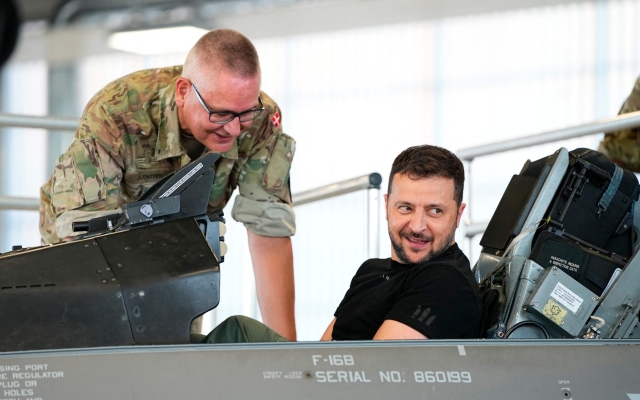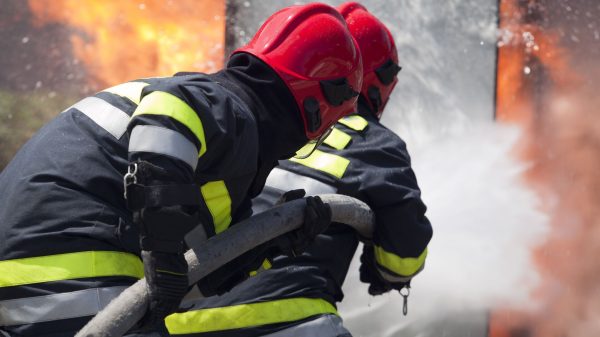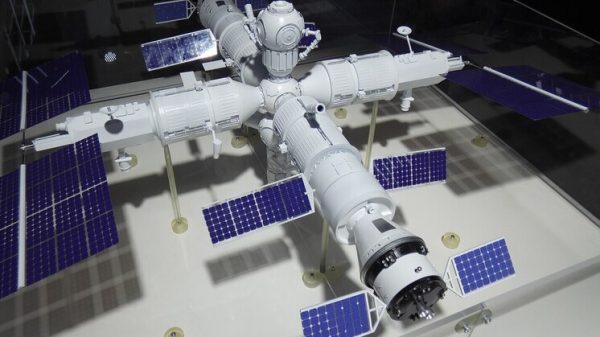 Vladimir Zelensky grins while sitting in the cockpit of an F-16 fighter jet. Photo: MADS CLAUS RASMUSSEN/AFP
Vladimir Zelensky grins while sitting in the cockpit of an F-16 fighter jet. Photo: MADS CLAUS RASMUSSEN/AFP
But Russian troops are again advancing along the front line. According to former Ukrainian army chief Valery Zaluzhny, the long-awaited F-16s are not the “silver bullet” the country is looking for.
< p>Instead, air warfare experts, including one of the few Western pilots to fly both on the F-16 and its Russian counterparts, they say they may not be the decisive advantage many had hoped for, but will nonetheless help the Kyiv Air Force get away. face to face with Russia in the skies over Ukraine.
Keeping Ukraine in the Air War
Perhaps the biggest impact the F-16 could have is simply keeping the Ukrainian Air Force in the war.
< p>Eventually, Ukraine's fleet of Soviet-era MiG-29s and Su-24s carrying British Storm Shadows will perish in the ongoing conflict.
Some of the planes will be shot down by Russia. The rest will remain in quarantine due to a lack of spare parts from Moscow-controlled companies to repair wear and damage.
Kyiv must switch to Western aircraft if its air force is to have any chance of surviving the protracted war.
“This is about sustainability. To survive as an air force in the medium term, Ukraine will have to switch to Western aircraft,” said Justin Bronk, senior air force fellow at the Royal United Services Institute. “They can no longer access the maintenance and service of Russian companies such as Sukhoi.”
The F-16 is by no means a long-term solution for Ukraine. Some of the planes being offered to Kyiv are about 40 years old, about the same age as many MiG-29s.
There are questions about how long their more fragile airframes will last in constant combat missions. But at least in the medium term, these aircraft will be a lifeline for the Ukrainian Air Force.
Survivability
Ukraine not only lacks aircraft, it also needs trained pilots to fly them.
It is important to note that the F-16 will provide Ukrainian pilots with much greater survivability compared to their Soviet-era counterparts.
While the MiG-29 has radars that can focus on a single target, the F-16 offers pilots much more greater situational awareness, which is vital if they want to keep an eye on threats.
“Soviet-style radar warning receivers are very basic and do not give pilots much information about the threats that are attacking them,” Professor Bronk said.< /p>
Western's aircraft are capable of tracking multiple targets, giving the pilot more information about when they are being targeted or even blocked by an enemy weapon system, he said.
Onboard systems can identify the most dangerous threat to the aircraft and communicate this to the pilot to improve decision making.
“The Western fighter pilot is given the tools to make autonomous decisions; the Soviet fighter pilot was given no such tools,” said Lt. Col. Fred “Spanky” Clifton, a retired U.S. Air Force pilot who flew both the F-16 and MiG. 29.
The F-16's Deadly Arsenal
Theoretically, the advanced weapons donated by Ukraine's allies would perform better when fired from the F-16.
«It will be much easier to integrate a range of weapons,» — said Professor Bronk.
>When the United States agreed to its allies' F-16 donation, it also signed export declarations for the AIM-120 Advanced Medium-Range Missile (AMRAAM) to be used with the aircraft.
The missiles will give the Ukrainian Air Force a first-time capability participate in the so-called air combat beyond visual range.
By combining the F-16 and AMRAAM, Ukrainian pilots will be able to target a distant target that they may not even be able to see—something their Russian adversaries have been able to do since the start of the war.
By increasing survivability, AMRAAMs represent “fire and forget” system. This means the Ukrainians can launch a missile and maneuver to safety, giving the weapon the ability to home in on its target.
According to Kiev Air Force spokesman Yuriy Inkhat, the variant of the missile donated to Ukraine will have a range of up to 110 miles. .
“But there will be restrictions on configuration and also restrictions on what the US will and will not allow in terms of arms exports,” Professor Bronk said.< /p>Do more with less
NATO Fighter — This is designed to give the pilot more functionality with fewer controls.
The F-16 can engage a target without taking the pilot's hands off the stick or throttle.
By comparison, the same task on the MiG-29 is a much more complex process, requiring the use of a series of switches and controls in cabin.
However, mastering the simplified controls of Western aircraft is not an easy task.
“Once you understand that, it will be easier to maintain tactical awareness,” Professor Bronk said. “Different Ukrainian pilots will adapt to Western systems and tactics at different speeds,” he added.
According to him, even the best MiG-29 pilots had difficulty switching to the F-16. “They couldn't unlearn what they were good at during their careers, while new pilots had an easier time learning from scratch.”
The F-16's Achilles heel?
One of the main factors that will limit the F-16's impact on the war is the large number of Russian surface-to-air missiles on the battlefield, including the S-300 and S-400 anti-aircraft systems, which can hit targets hundreds of miles away.
Security sources describe the threat of Russian air defense systems as «pretty ugly», not taking into account the smaller and more mobile systems also deployed by Moscow troops on the ground.
“If this were just an air war, the F-16 would be a huge step forward, but with ground threats the situation becomes more complex,” Lt. Col. Clifton said.
But perhaps the biggest challenge for Ukraine will be creation of infrastructure for flights. The F-16, designed to operate from extremely smooth and clean runways.
Ukrainian runways will have to be constantly cleared of debris in case it gets into the aircraft's air intakes, which, unlike Soviet aircraft do not have built-in protection.
Kyiv will also have to create a sufficient amount of waste. airfields to allow aircraft to move around the country and prevent them from being detected and targeted by Russian missile attacks.
“The F-16 will be a big improvement over the Russian Su-27 and MiGs. -29 and will make Ukrainian fighter pilots more lethal, but I’m not sure the F-16 will be a game changer,” he concluded.






















































Свежие комментарии